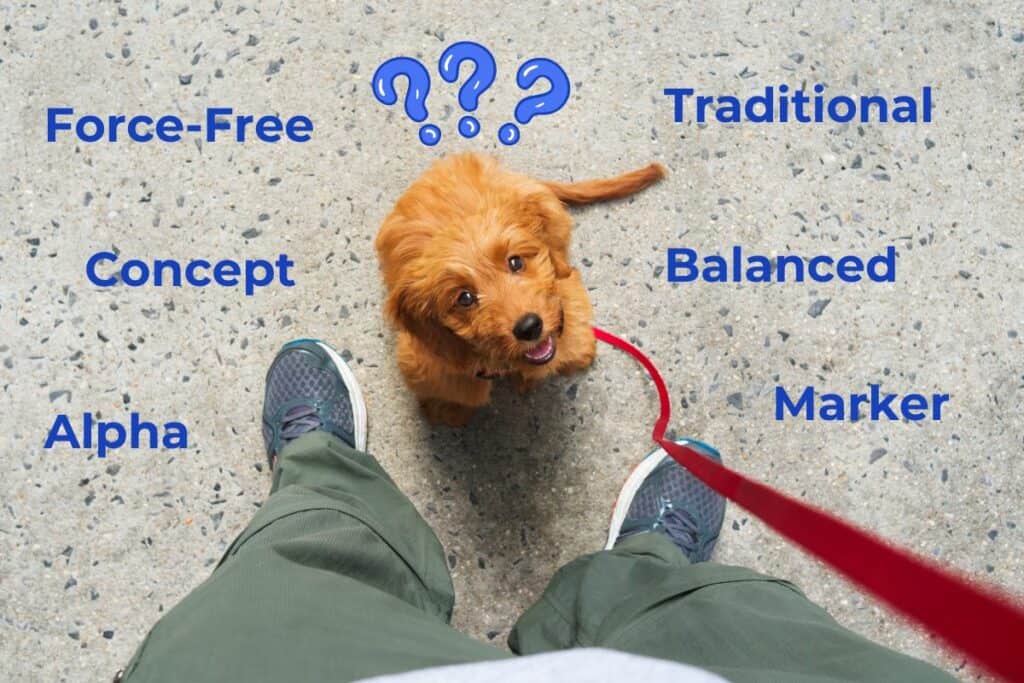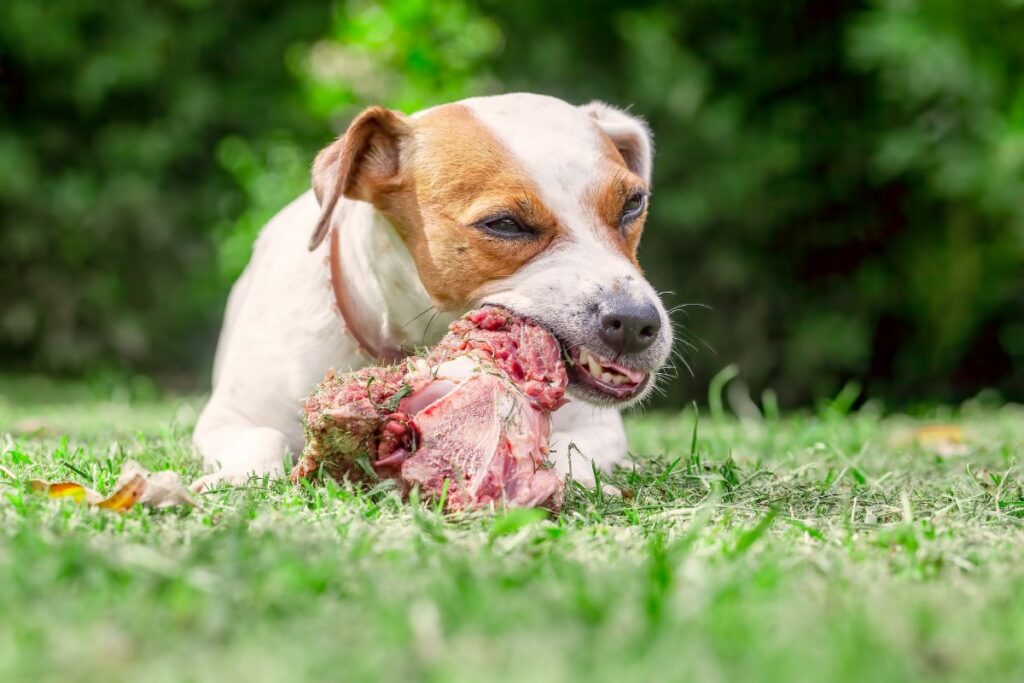The world of dog training is always evolving and to stay ahead of competition trainers are always looking to set themselves apart. An easy way to do this is come up with new lingo that describes their dog training methods. As a pet parent, navigating the training process with a new pup is hard enough. It is critical to understand what to expect from a trainer and how they can help you through your training journey.
This article can be your guide to understanding common training lingo so you can select the right trainer for you and your dog.
Types of Dog Training
Often confused with training methods, there are a handful of types of dog training. When determining the type of dog training, you are simply deciding your training goals. Are you looking to train your new puppy in basic manners and skills or are you wanting to train a therapy dog to volunteer and help your community.
Below are the most common types of training based on your training goals:
- Pet Skills & Manners Training (aka. Obedience Training)
- Behavior Modification
- Therapy Dog Training
- Service Dog Training
- Dog Sport Training
- Search & Rescue Training
- Scent Detection Training
- Protection Training
Dog Training Methods & Terminology
There is no simple hierarchy of dog training methodologies. There are too many concepts at play that make it hard to organize training methods into a list. As described above, there are different training goals, such as obedience training versus dog sport training. Within each, there are different classifications of training methods such as reward-based or compulsion training. Even withing these, there are different techniques such as luring versus capturing a behavior.
If can be hard to navigate the complex terminology. In a world where trainers are all trying to differentiate themselves, the lingo keeps changing. This is why we’ve created a declassified list that covers all the popular terms, and what each really means. Before reviewing the list, it’s critical that you understand the concept of operant conditioning. This theory of learning explains the science behind each of the training methods listed below and can help you determine which is best for you and your dog.
What is Operant Conditioning?
Dogs, like people, learn in many ways, whether through associations, social learning, or cause and effect. Operant conditioning is the learning theory that encompasses all the training methods below. Operant conditioning makes use of rewards and consequences in changing behavior. It is based on the idea that behaviors followed by positive outcomes (rewards) are more likely to be repeated, while those followed by negative outcomes (punishments) are less likely to be repeated. This learning process involves four key components:
- Positive Reinforcement: Adding something pleasant following a behavior to increase the likelihood of that behavior being repeated. For example, giving a dog a treat for sitting on cue encourages the dog to sit more often.
- Negative Reinforcement: Removing something unpleasant following a behavior to increase the likelihood of that behavior being repeated. For example, stopping a mildly unpleasant stimulus (like pressure) when a dog performs the desired action (such as sitting down).
- Positive Punishment: Adding something unpleasant in response to a behavior to decrease the likelihood of that behavior being repeated. For example, using a loud noise to discourage jumping.
- Negative Punishment: Removing something pleasant in response to a behavior to decrease the likelihood of that behavior being repeated. For example, taking away a toy when a dog nips or bites.
Why is it important?
The reason we encourage you to learn about operant conditioning is because these four categories are the basis for every training methodology. The sad truth is that most people, including trainers, don’t understand the science behind why their training works, and they commonly mislabel their training method because of it.
You commonly hear trainers describe themselves as “positive only”. What they really mean is that they focus on rewards and things the dog likes, most likely using positive reinforcement. But this can be confusing because “positive punishment” is the complete opposite. It relies on harsh consequences and pain to train a dog. You will also hear trainers who use pain and compulsion (positive punishment) describing their methods as “Negative Reinforcement”. They think the word negative refers to the use of pain when it really means, you are removing something the dog doesn’t like.
Don’t worry if this is confusing. We will explain each dog training method in detail, as it relates to operant conditioning, below.
16 Terms Used to Describe Dog Training Methods
DISCLAIMER: DogNerdly and all its members believe in the humane treatment of dogs and do not condone the use of force, punishment, or coercion in dog training. Of the methods listed below, we recommend finding a trainer with a heavy focus on rewards. When seeking out a qualified trainer, we recommend searching for force-free, positive reinforcement, or marker/clicker trainers. All other training terms will produce a mix of results that could lead to hiring a trainer who may do more damage than good.
Below is a list of training terms related to methodologies. The point of this list is to help you decipher what kind of trainer you are talking to or wish to seek out. The list is divided into 3 categories: Appetitive, Aversive, and General. Appetitive and Aversive training terms are relatively straight forward, but the general category includes terms that are overused and are misleading. These general terms are used by most trainers to make their methods sound more official, but they provide little context to determining a trainer’s methodology.
Appetitive Training Methods
Appetitive Training: This is a general term that refers to any method of training that primarily uses rewards and positive reinforcement. Treats and toys are used to drive behavior change because the dog has an “appetite” for them, and it creates a positive experience.
- Marker/Clicker Training: A form of positive reinforcement training that uses a sound (like a clicker) to mark the exact moment a dog performs the desired behavior, followed immediately by a reward. It helps the dog associate the sound with positive outcomes, making it clear which behavior is being rewarded. Marker training is a technique used in appetitive and force-free training and focuses on the use of rewards instead of punishment or pain.
- Force-Free Training: Exclusively uses positive reinforcement and negative punishment (withdrawing something the dog wants, like attention or toys, to decrease the likelihood of unwanted behavior) techniques. It avoids all forms of physical correction, focusing on rewarding desired behaviors to train the dog. Force-free training has become more popular over the years because it encourages healthy interaction and prevents the development of unwanted behaviors.
- Concept Training: Instead of focusing on skills and manners, concept training focuses on developing certain traits or characteristics in dogs. Using positive reinforcement and games that dogs enjoy, we can strengthen a dog’s Confidence, Optimism, Resilience, Grit, etc. Improving on these qualities makes all other training easier and prevents unwanted behaviors from occurring. Concept training can be looked at as a foundation to all other training.
Aversive Training Methods
Aversive Training: Training that primarily utilizes unpleasant stimuli to discourage unwanted behaviors. This approach can include positive punishment (adding something unpleasant following a behavior to decrease its occurrence) and negative reinforcement (removing something unpleasant when the desired behavior occurs to increase the likelihood of the behavior).
- Alpha Dog / Dominance Training: Based on the debunked theory that dogs are constantly striving for dominance and humans must establish themselves as the "alpha" leader. This method often uses positive punishment and negative reinforcement, emphasizing submission cues from the dog. This is a dying method because of the lack of science and misunderstanding of what motivates a dog. We highly recommend staying away from any trainer that uses the term “alpha” or tells you to dominate your dog.
- Balanced Training: Balanced training makes use of positive reinforcement (rewarding desired behaviors) AND forms of punishment (to discourage unwanted behaviors). The term “balanced” can be misleading because it implies a more harmonious approach, but the use of punishment often overshadows the use of rewards. The term “balanced training” has become synonymous with aversive or compulsion training because most of these trainers lean heavily towards the use of punishment.
- Compulsion Training: Relies on forcing the dog to comply with commands, often using corrections or physical manipulation. It primarily uses positive punishment and negative reinforcement to shape behavior. This method is becoming less popular as we learn more about the effects of punishment on the emotional wellbeing of dogs. Compulsion training is known to cause increased fear and aggression that can lead to many other unwanted behaviors.
- Nepopo® Training: This term is a trademarked training method developed by Bart Bellon. The name "NePoPo®" is an acronym that stands for "Negative-Positive-Positive," which succinctly describes the philosophy behind the training technique. This training aims to be unique but is very similar to any other balanced training methods. It uses positive punishment to stop unwanted behaviors and positive reinforcement to encourage the correct behavior. The term NePoPo® is nothing more than an attempt to differentiate itself from the rest of the aversive training community.
- Traditional Training: This refers to the dying breed of dog trainers who are committed to the use of choke, prong, and shock collars, despite the damage they can cause a dog. Unlike balanced trainers, they tend to focus primarily on positive punishment (pain and coercion) to change behavior and avoid the use of rewards. We highly recommend avoiding trainers who use aversive tools.
General Training Terms That Can Be Misleading
- Relationship-Based Training: This is a general term used for training that encourages a healthy bond between dog and handler. Trainers of all methodologies will use this term, despite the accuracy. It has become more of a marketing term than an actual training method. If you find a trainer that focuses on “relationship building”, they should be using rewards and positive reinforcement. If this isn’t the case, and punishment is used, they are falsely identifying, and their methods are doing more harm than good.
- Reward-Based Training: Similar to appetitive training, this is a general term that describes any method that uses rewards (treats, praise, toys) to reinforce desired behaviors, employing positive reinforcement. It avoids the use of punishment, creating a positive learning environment for the dog. All “force-free” trainers are reward-based but not all reward-based trainers are “force-free” because some may still use punishment. Since most trainers don’t exclusively use force or punishment, they are not lying when they say they use rewards. This term alone won’t help you narrow down a specific training method.
- Science-Based Training: This is another marketing term used to make trainers sound more official. The term “science-based” encompasses all training because all the methods listed here use a form of operant conditioning to change behavior. There is nothing inherently wrong with the use of the term “science-based” but beware trainers who can’t explain the science behind their methods, because they likely don’t understand what they are doing.
Every trainer is trying to differentiate themselves so new terminology and methodologies pop up regularly. You may find that this list doesn’t cover all of them. All dog training uses one or more of the four categories of operant conditioning. Once you understand these four categories, you can better understand what kind of trainer you wish to work with.
For best results, we highly recommend working with force-free trainers, because they tend to better understand the science of operant conditioning. By refusing to use force or punishment they can provide positive results without the risk of damaging the human-pet bond or causing fear or aggression to develop.

Joseph Schifano is the President of The Academy of Pet Careers and Founder of DogNerdly.
With over 20 years of professional pet experience, Joseph got his start as an owner/operator of a 7-figure, all-inclusive pet care business. From there, he purchased The Academy of Pet Careers with a hopes of improving the quality of care provided by industry professionals. This role allowed Joseph to rub shoulders with some of the biggest names in the industry, and gain knowledge in every aspect of pet care.
After witnessing the popularity of social media influencers and the amount of misinformation being taught to pet parents, Joseph decided to create DogNerdly. The goal was to provide science-backed education for the average dog nerd in order to create a world where dogs and humans can live a more harmonious and empowered lifestyle.




